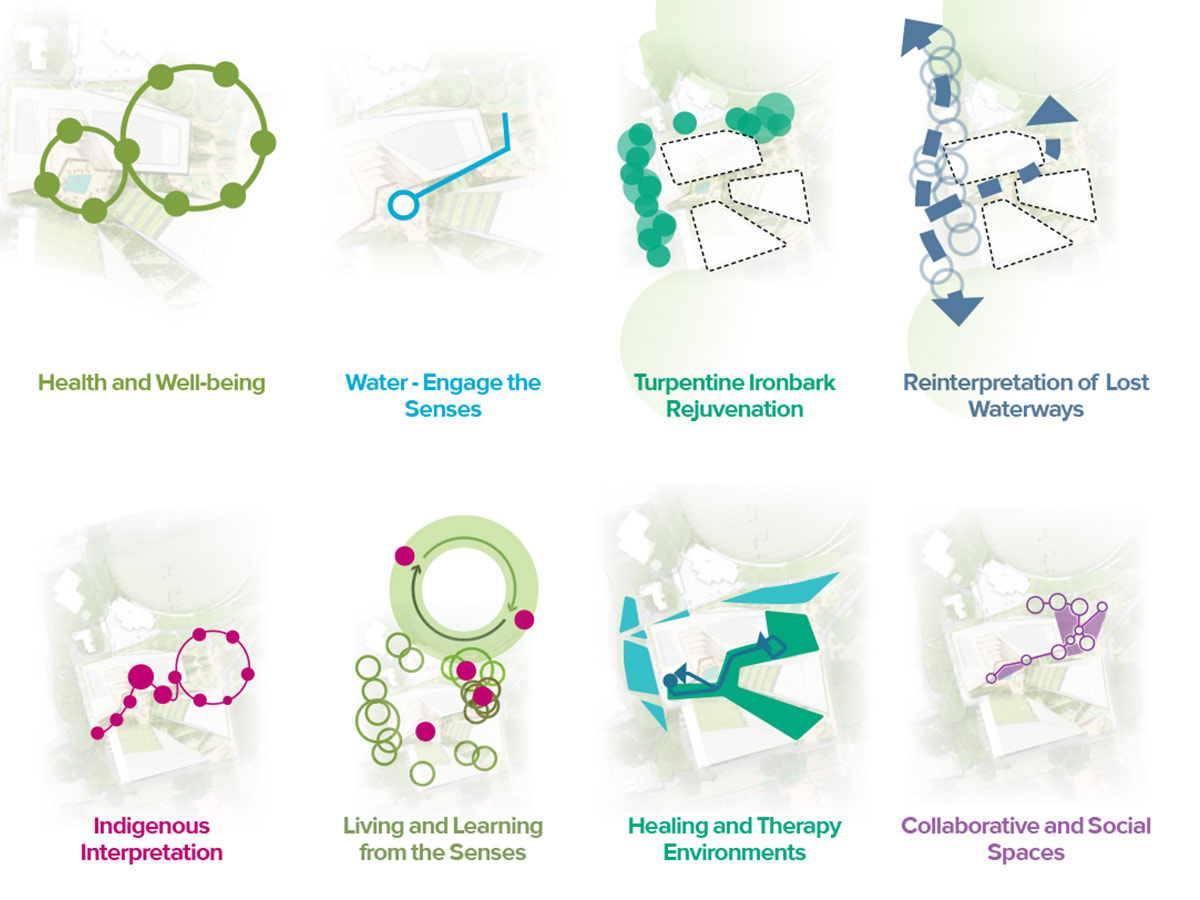About the Project
Project Awards
- 2021 // NSW AILA Landscape Architecture Award (Civic Landscapes)
Arcadia Landscape Architecture has conceptualised and delivered the landscape and public realm for the Susan Wakil Health Building on Gadigal country at the University of Sydney.
Arcadia Landscape Architecture has conceptualised and delivered the landscape and public realm for the Susan Wakil Health Building on Gadigal country at the University of Sydney.
The new state-of-the art facility integrates clinical, research and teaching environments for the University of Sydney’s Susan Wakil School of Nursing and Midwifery, Central Clinical School, the Sydney School of Health Sciences and other components of the Faculty of Medicine and Health.
Brief
Arcadia collaborated with architects, Billard Leece Partnership and Diller Scofidio + Renfro, and the University of Sydney to deliver a landscape which achieves the objective of creating a healthy workplace and a place of learning of the future.
Arcadia collaborated with architects, Billard Leece Partnership and Diller Scofidio + Renfro, and the University of Sydney to deliver a landscape which achieves the objective of creating a healthy workplace and a place of learning of the future.
The Susan Wakil Health Building was designed as an extension of the landscape, embodying the University’s Wingara Mura design principles.
The design creates a new common ground for the University, the Royal Prince Alfred Hospital and the Charles Perkins Centre, while respecting the site’s historic significance as a meeting place. Users of the space include students and academic, local residents and visitors, University and RPA Hospital staff.
The Susan Wakil Health Building is an environment that engages mind and body by activating movement, reflection, and spaces of social gathering promoting a positive relationship with the external environment and collaboration between teaching, learning and the public space.

Design Principles & Process
The Wakil Gardens are an interpretation of the cycle of healing, stirring the body, mind and soul to reflect the Gadigal people’s approach to healing through the engagement of all the human senses.
The Wakil Gardens are an interpretation of the cycle of healing, stirring the body, mind and soul to reflect the Gadigal people’s approach to healing through the engagement of all the human senses.
Arcadia’s landscape strategy reimagines the fundamental effects of the landscape character in a contemporary setting, to engage the senses and elicit a physiological response to place.
With the Susan Wakil Health Precinct located at the intersection of two waterways historically significant and sacred to the Gadigal people, the design team worked together to create a precinct that shares the narrative and cultural significance of this site.
Context & Materiality
Susan Wakil Health Precinct is a united design where Indigenous connection to the land has been integrated in many ways. Arcadia’s landscape includes Indigenous artwork and a planting strategy with the underlying theme that landscapes heal.
Susan Wakil Health Precinct is a united design where Indigenous connection to the land has been integrated in many ways. Arcadia’s landscape includes Indigenous artwork and a planting strategy with the underlying theme that landscapes heal.
As a gateway to the precinct, the Dillybag sculpture ‘juguma’: sits within a planted landscape that has a direct dialogue with the sculpture. Judy Watson’s artwork celebrates Indigenous customs and culture through a large-scale woven metal sculpture representing the dillybag. Arcadia’s Indigenous Landscape Strategist engaged closely with Indigenous artist, Judy Watson, to ensure the surrounding planting strategy had a direct dialogue with the sculpture, using plants that are either used in weaving practices or edible plants, some medicinal, complementing the sculpture’s form and framing sight lines to the artwork. There are also a number of feature Grass trees used, both to support the story of weaving and speak to the Gadigal People, whose Moety and name-sake is the Xanthorrhoea or Cadi/gulgadya tree.
The planting strategy for the Susan Wakil Health Precinct aims to strengthen the Indigenous vegetation of the local area to create an Urban Bushland character. By reintroducing lost vegetation communities, such as the Sydney Turpentine Ironbark Forest, the site can enhance a sense of scenic heritage through the distinctive characteristics found in bush habitat of colour, smell and texture which give the site a uniquely Australian quality. By employing an Urban Bushland approach, the site will not only enhance the character and culture of the area, but also serve as a site of shelter and food for local fauna.
Orphans School Creek, which rose in Grose Farm in the vicinity of the site, is one of the casualties of urban development. Once a crystal-clear stream, it provided foods by fishing, hunting and gathering plants for the Cadigal people. Native species that were once abundant in this area, will be reinstated and celebrated in the reinterpretation of this water course shown in the water features in Upper and Lower Wakil Gardens.
Project completion
With ‘juguma’ in the foreground, visitors are welcomed into the Lower Wakil Gardens, which acts as an extension of the building. Fluid indoor and outdoor collaboration zones are created with alcove sandstone seating, a cascading water feature and raised garden beds.
With ‘juguma’ in the foreground, visitors are welcomed into the Lower Wakil Gardens, which acts as an extension of the building. Fluid indoor and outdoor collaboration zones are created with alcove sandstone seating, a cascading water feature and raised garden beds.
The Upper Wakil Garden is a multi-purpose space at the heart of the precinct. With a skim water feature and dense rainforest planting, Upper Wakil is designed to provide diverse, comfortable, and stimulating breakout and social spaces, to complement to the indoor learning spaces.
These water features are connected by a paving strategy using contrast to embrace the inherent qualities of water, exciting the senses and enhancing the experience, while also providing contrasting character and definition of these spaces.